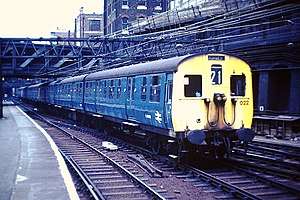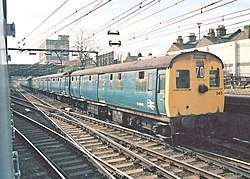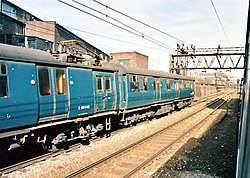British Rail Class 306
The British Rail Class 306 was a type of electric multiple unit (EMU) introduced in 1949. It consisted of 92 three-car trains which were used on newly electrified suburban on the Great Eastern Main Line between Shenfield and London Liverpool Street.
| British Rail Class 306 | |
|---|---|
 306022 at Liverpool Street in 1975 | |
| In service | 1949 - 1981 |
| Manufacturer | Metro Cammell and BRCW |
| Constructed | 1949[1] |
| Refurbished | 1960-1961[2] |
| Number built | 92 trainsets |
| Formation |
|
| Design code | AM6 |
| Fleet numbers |
|
| Capacity |
|
| Operator(s) | British Rail |
| Depot(s) | Ilford[1] |
| Line(s) served | Great Eastern Main Line [4] |
| Specifications | |
| Train length | 177 ft 7 in (54.13 m)[2] |
| Car length | |
| Width | 9 ft 3 in (2.82 m)[5] |
| Height | 13 ft 1 in (3.99 m)[2] |
| Doors | Bi-parting sliding[2] |
| Articulated sections | 3 |
| Maximum speed | 75 mph (121 km/h)[2] |
| Weight |
|
| Traction motors | 4 × EE 504[5] |
| Power output | 4 × 210 hp (160 kW)[5] |
| Electric system(s) |
|
| Current collection method | Pantograph |
| UIC classification | Bo'Bo'+2'2'+2'2' |
| Bogies | Thompson[7] |
| Braking system(s) | Air (EP/Auto)[2] |
| Coupling system | Screw[1] |
| Multiple working | Within class |
| Track gauge | 4 ft 8 1⁄2 in (1,435 mm) |


Overview
Class 306 trains were built to a pre-World War II design by Metro Cammell (Driving Trailer) and Birmingham Railway Carriage and Wagon Company (Driving Motor Brake and Trailer) and were equipped with English Electric traction equipment. Each carriage featured two sets of twin pneumatic sliding passenger doors, which could be opened by either the guard or the passengers, who could use buttons fitted inside and outside the doors. The order was placed by the LNER in 1938 but official delivery did not commence until February 1949.[8]
When built the trains were energised at 1,500 V direct current (DC) which was collected from overhead wires by a diamond pantograph located above the cab on the Motor Brake Second Open (MBSO) vehicle.
In the early 1960s, the overhead wires were re-energised at 25,000 V alternating current (AC) (and 6,250 V AC in the London area) and the trains were rebuilt to use this very different electrical system. A transformer and rectifier unit was fitted to the underframe between the bogies of the intermediate carriage and the pantograph, now a more modern Stone Faiveley AMBR design, was moved to the roof of this carriage. Because this reduced the headroom inside the train, the guard's compartment was relocated to be directly below the pantograph. The trains were then re-numbered 001-092 with the last two digits of each carriage number (previously numbered in the LNER coaching series) the same as the unit number.
Operation
Units being made up of three coaches, trains were usually formed on three units (nine coaches)[8] although off-peak trains formed of only two units (six coaches) could be seen. This meant that the standard formation could carry 528 seated passengers plus another 696 standing, making 1,224 passengers, compared with about 1,000 passengers in the steam trains that they replaced.[8]
There is a record of a single three-coach unit hauling a Class 47 and train into Chelmsford after the locomotive failed on a London Liverpool Street to Norwich express.[9]
Withdrawal and preservation
The Class 306 trains were withdrawn in the early 1980s, with 306017 preserved at Ilford depot. It has been repainted in a near original green livery, albeit with a yellow warning panel on the front to comply with present-day safety regulations. In the early 2000s, it was restored to operational condition by First Great Eastern.[10]
The unit was in store at MoD Kineton awaiting the resolving of issues such as asbestos contamination. The contamination was removed at Eastleigh Works and the unit was transferred by rail to the East Anglian Railway Museum in June 2011 for display as an exhibit, under a 4-year loan agreement from the National Railway Museum. It was moved to Locomotion: the National Railway Museum at Shildon in October 2018 so it can be assessed before restoration.[11] It is scheduled to move to York when space becomes available.[10][12]
See also
- Class 506 EMUs - similar to the Class 306 EMUs, but built for the Manchester-Sheffield-Wath electric railway
References
- Fox 1987, p. 52
- "Class 306". The Railway Centre. Archived from the original on 15 June 2011.
- Longworth 2015, p. 22
- Longworth 2015, p. 21
- Longworth 2015, p. 349
- Longworth 2015, p. 350
- Longworth 2015, pp. 349–350
- Glover, John (2003). Eastern Electric. Hersham: Ian Allen. pp. 38–40. ISBN 0 7110 2934 2.
- "Motive power miscellany". Railway World. Vol. 30 no. 345. Shepperton: Ian Allen. February 1969. p. 93.
- " What future for the last 306?" Rail Express issue 247 December 2016 pages 16-19
- Locomotion (18 October 2018). "Class 306 Electric Multiple Unit set number 306 017 has recently arrived at Locomotion - for assessment and initial conservation in advance of a restoration programme.pic.twitter.com/WlVAJbmeXp". @LocomotionSHD. Retrieved 6 May 2019.
- Class 306 Science Museum Group
Sources
- Fox, Peter (1987). Multiple Unit Pocket Book. British Railways Pocket Book No.2 (Summer/Autumn 1987 ed.). Platform 5 Publishing Ltd. ISBN 0906579740. OCLC 613347580.CS1 maint: ref=harv (link)
- Longworth, Hugh (2015). British Railways Electric Multiple Units to 1975. Oxford Publishing Co. ISBN 9780860936688. OCLC 923205678.CS1 maint: ref=harv (link)
Further reading
| Wikimedia Commons has media related to British Rail Class 306. |